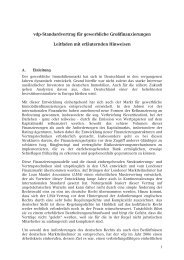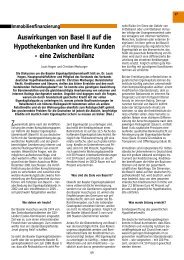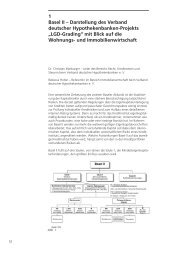The Pfandbrief 2011 | 2012
The Pfandbrief 2011 | 2012
The Pfandbrief 2011 | 2012
Create successful ePaper yourself
Turn your PDF publications into a flip-book with our unique Google optimized e-Paper software.
“Benchmarks” are reference or comparative values used for measuring<br />
performance and are expressed in the form of an indicator. Similarly,<br />
“benchmarking” describes the continuous methodical comparison, for<br />
example, of pre-defined performance against the performance of the benchmark.<br />
In so doing, it must be determined which benchmark is to be used<br />
(e.g. iBoxx EUR German Covered Bonds or indices with a certain maturity<br />
band, e.g. 3-5 years) and which indicators are to be used to determine<br />
performance (e.g. total return or absolute spread performance). Establishment<br />
of the benchmark is of particular importance here. From the investor<br />
standpoint, the respective investment guidelines are particularly to be<br />
taken into account when selecting the “correct” benchmark.<br />
In addition to volume criteria (e.g. >EUR 1 billion), these might include, in particular, ratings<br />
criteria (e.g. only AAA-rated covered bonds or only covered bonds of issuers with a specified<br />
minimum rating), country allocation criteria (e.g. only the Eurozone), or criteria relating to<br />
the corresponding legal framework (e.g. only covered bonds subject to special laws on covered<br />
bonds). This gives rise to a variety of possible combinations, which in some cases are<br />
implemented in such a way that existing indices are modified for the individual investor, thus<br />
creating an individual benchmark. In our case, benchmarking involves the comparative evaluation<br />
of the investment performance of a specified <strong>Pfandbrief</strong>/covered bond against the performance<br />
of the respective covered bond index.<br />
45<br />
Clarification of Benchmark<br />
By way of clarification, we would like to point out that in the world of covered bonds, the<br />
term “benchmark” is often used as a shorthand for the criterion of issuance volume. With the<br />
introduction of the Jumbo <strong>Pfandbrief</strong> in 1995, which had a minimum issuance volume of DM<br />
1 billion, and continuation of the brand with the Jumbo Covered Bond, which has a minimum<br />
issuance volume of EUR 1 billion, the term “benchmark covered bond” is often associated<br />
with this. Over the past 18 months, the volume-based term has now been extended, with market<br />
acceptance, to include covered bonds with a minimum issuance volume of EUR 500 million.<br />
2003 This is nahm also die evident Taktzahl in the der current Novellierungen discussion des of whether, Rechtsrahmens for example, für die the <strong>Pfandbrief</strong>-<br />
criterion of the<br />
Seit<br />
emittenten iBoxx Covered deutlich Bond zu: Index die Abschaffung regarding minimum der Gewährträgerhaftung issuance volume should und die be Modifizierung changed from der EUR<br />
Anstaltslast, 1 billion to EUR die zunehmende 500 million. In Bedeutung addition to gemischter such aspects gegenüber as secondary reinen market Hypothekenbanken,<br />
liquidity, die significance Internationalisierung of bond volume des is <strong>Pfandbrief</strong>absatzes also illustrated by und the relationship der aufkommende to the topic Wettbewerb at hand, mit i.e. ausländischen<br />
significance Covered of securities Bonds indices, waren since wesentliche lowering Beweggründe the minimum des issuance Gesetzgebers volume für for die the Schaf-<br />
iBoxx<br />
the<br />
fung Index des would <strong>Pfandbrief</strong>gesetzes, result in the addition das Hypothekenbankgesetz, of (currently) 113 covered Öffentliches bonds with <strong>Pfandbrief</strong>gesetz a volume of EUR sowie 74<br />
das million. Schiffsbankgesetz When we use “benchmark” im Jahr 2005 in auf this sich article, vereinte we und are referring grundlegend to affiliation neu gestaltete. with an Über index.<br />
die Abkehr vom Spezialbankprinzip hinaus wurden weitere Neuerungen wie eine verbesserte<br />
Regulierung der Überdeckungsanforderungen, Transparenzvorschriften des § 28 PfandBG<br />
sowie Anforderungen an das Liquiditätsmanagement der Deckungsmassen in das Gesetz aufgenommen.<br />
Diese Maßnahmen wurden ermöglicht bzw. maßgeblich flankiert durch die Schaffung<br />
der Rolle des Sachwalters im Jahr zuvor, durch den die insolvenzrechtliche Abschottung<br />
der Deckungsmassen perfektioniert wurde.<br />
Im Folgenden werden die praktischen und gesetzlichen Anforderungen an das Deckungsgeschäft<br />
einer <strong>Pfandbrief</strong>bank im aktuellen regulatorischen Umfeld beschrieben und am Beispiel<br />
einer zentralen Organisation des Deckungswesens gezeigt, wie diesen Anforderungen in<br />
der Praxis Rechnung getragen werden kann.
















